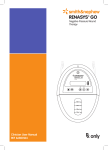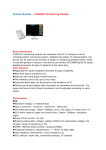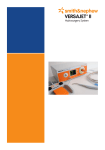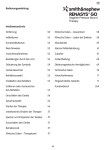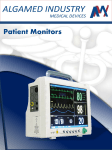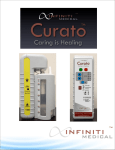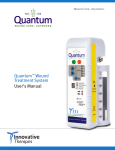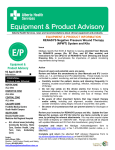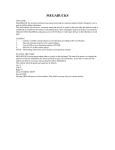Download Questions? Call the 24/7 NPWT Clinical Support Hotline at 1
Transcript
Questions? Alarm Messages Symbols Power Button Turns the device on and off. Battery Indication Shows the status of battery life. Flashes when the battery life reaches levels that require user intervention. Up Selector Allows the pressure setting to be increased and scroll through menu options. Down Selector Allows the pressure setting to be decreased and scroll through menu options. Keypad Lock Locks the keypad to restrict accidental adjustment of therapy. When activated the light will illuminate. Audio Pause/Alarm Suppress Silences the alarm for approximately 2-3 minutes. Start Therapy/Select Allows therapy to be started or paused. It is also used to confirm settings within therapy. The Battery has up to 3 hours therapy time remaining. The battery has up to 1 hour therapy time remaining. Call the 24/7 NPWT Clinical Support Hotline at 1-866-998-NPWT (6798). Quick reference guide 1. Installing the canister - Remove paper tape around the canister tubing to release tubing to the full length. - Open both of the orange clips. - Align the canister so that the Volume marks are facing forward. - Push the canister gently over the inlet port of the device. - Engage both orange clips (clips will click when they are properly engaged). The battery has only 2 minutes of therapy time remaining. After 2 minutes in the extremely low state the device will power off. The vacuum level is low or there is a leak in the system for longer than 30 seconds. (See User Manual for details for resolution) 2. Start up of device The system has encountered a high vacuum condition. (See User Manual for details for resolution) The system has encountered an excessively high vacuum (of >235mmHg). (See User Manual for details for resolution) Press and hold the Power button for 2 seconds until start up message appears. The system detects that the canister is full or that there is a blockage in the system. (See User Manual for resolution) The system has detected a significant leak for more than 1 minute (See User Manual for resolution) *This feature available with software version 0.66 and later. 4. Start therapy Use Up and Down to adjust. Press Select to start therapy. 5. Check dressing for a good seal The device has an unrecoverable error. (See User Manual for resolution) The device has been left in standby mode for longer than 15 minutes. Either select vacuum setting and start therapy or shut off the device until therapy is required.* 3. Select vacuum setting Look for “raisin-like” appearance. Wound Management Smith & Nephew, Inc. 970 Lake Carillon Drive Suite 110 St. Petersburg, FL 33716 USA Customer Care Center 1-800-876-1261 T 727-392-1261 F 727-392-6914 Listen for a “hissing” sound, indicating a leak. www.smith-nephew.com www.myrenasys.com www.globalwoundacademy.com ©2010 Smith & Nephew, Inc., All rights reserved. ™Trademark of Smith & Nephew. Certain marks Reg. US Pat. & TM Office. RA16000 Feel the dressing, which should be hard to the touch. Possible site of leak Where drain exits film Wrinkle or crease Skin fold or crevice REN-0011-1110 Intervention Pinch paste around drain. (if applicable) Secure area where tube exits with blue tape. Seal film edges with blue tape or film dressing. If hole found in transparent film patch with adhesive transparent film. Dressing the wound – RENASYS™-F/P Dressing Application: Dressing the wound – RENASYS™-G Gauze Dressing Utilizing Basic Technique: Use clean or sterile techniques for application depending on institutional protocol. Step 3 Cut the foam dressing to fit the size and shape of the wound and place into wound cavity. Step 1 Debride any necrotic/eschar tissue if necessary. Cleanse wound bed and pat dry per protocol. • Thorough wound cleansing should occur with each dressing change. Foam should fill the wound cavity and it may be necessary to stack pieces of foam in deep wounds. A non-adherent dressing may be applied to the wound prior to placing the foam into the wound bed if required. Step 2 Apply skin sealant to periwound area. (Skin sealant not included as part of kit). • Protect the periwound from exposure to moisture and adhesive. Step 4 Cover foam with transparent film. Film should extend 2 in. (5.1 cm) beyond wound margin to facilitate adequate seal. • Film should be securely anchored to periwound area to maintain a good seal. WARNINGS: • Foam should be cut to fit loosely into wound bed. Do not tightly pack or force foam into any areas of the wound. • Do not cut the foam directly over the wound bed to avoid foam fragments from falling into the wound. Rub the edges of the foam to remove any loose fragments after cutting. • If multiple pieces of foam are needed to cover the wound bed, count and record how many foam pieces are present. • If a tunnel exists, cut the foam longer than the tunnel to ensure that contact is made with the foam in the primary wound bed/cavity. • Do not place foam into blind or unexplored tunnels. Utilizing Bridging Technique: Bridging Away from Wound and Dressing Small Wounds This technique allows the Port and tubing to be redirected to a non-weight bearing area. This technique should also be used on wounds that are smaller than the Port 1.5 in. (3.8 cm). Step 6 Remove the liner from the Port Dressing. Position the center opening of the Port Dressing so it surrounds the hole in the film. Step 7 Use gentle pressure to anchor the Port Dressing to the transparent film. Step 5 Cut a small hole .25 in. (0.6 cm) in the center of the film, over the foam. Remove excess trimmed film. 1 5b 9 Gauze wound dressings should be changed 48 hours after the initial application of therapy. If no leak is present and the patient is comfortable, dressing changes should occur 2-3 times per week. Foam wound dressings should be changed every 48 hours during therapy. Step B6 Cover both the wound and foam bridge with transparent film. Film should extend 2in. (5.1 cm) beyond wound margin to facilitate adequate seal. • Film should be securely anchored to periwound area to maintain a good seal. Step B7 Cut a small hole .25 in (0.6 cm) in the center of the film, over the bridged foam. Remove excess trimmed film. Step B4 Cover intact skin with transparent film where bridge will be placed. • The center opening of the Port Dressing will be aligned over the hole to deliver negative pressure. Dressing changes • The center opening of the Port Dressing will be aligned over the hole to deliver negative pressure. Step B8 Proceed with Step 6 – Step 9, utilizing Basic Technique. Cleanse wound bed and pat dry per protocol. 2 For channel drain, wrap layer of gauze around drain. NOTE: If placing channel drain directly into a sinus tract, no gauze is necessary on the portion of the drain in the tract. Create a seal by pinching the ostomy paste. 10 Secure the drain tubing with waterproof tape. 3 The RENASYS™ GO device can be used with the 300ml/cc RENASYS GO Canister or the RENASYS GO Large Canister (750ml). The canister should be changed at least once a week or when full. Canisters may have to be changed regularly within single-patient treatment episodes if exudate levels are high. 6a Apply skin sealant to periwound area. Canister selection Canister tubing 11a Disconnect the tubing Apply part of ostomy strip paste to wound edge to secure drain in position. 6b Trim single layer of non-adherent gauze and lay across wound bed. 11b 4 Connecting the tubing Cap the tubing Place remainder over top of drain and pinch in place. 7 Cut the drain approximately 1 inch or 2.5 cm shorter than the base of the wound. Curl the drain if using a channel or round drain. Step 8 Smooth the dressing down while removing the frame. Step 9 Attach the RENASYS Port tubing to the canister tubing and activate the device. Finished and leak-free dressings should be firm to the touch. Note: If there is concern that the port may create pressure at the wound due to the wound location, utilize the bridging technique. Secure the RENASYS™ Port tubing with tape or adhesive strips to minimize tension on the port. 5 Step B5 Cut additional foam and place on top of transparent film to form the bridge. Ensure the foam bridge is wider than the port diameter 1.5 in. (3.8 cm). Important: Contact must be made between the bridge foam and the foam in the wound bed (overlap). Fill wound with saline-moistened antimicrobial gauze. Gauze should loosely fill to surface of wound. Avoid over-packing. Secure the drain tubing to the canister tubing at the adaptor site. Connect the canister tubing to the canister and begin vacuum, ensuring canister is installed correctly. 12 8 Apply layer of saline-moistened antimicrobial gauze to wound bed. Position drain on top of gauze. Place transparent dressing over the wound and seal. Finished dressing Will have a “raisin-like” appearance and be firm to the touch. CAUTION: The drain should never be placed in an unexplored fistula tract. CAUTION: Do not connect the tubing to or cover the end of the t-connector that is inserted in the canister tubing. Notes: • Please refer to the RENASYS-F/P and RENASYS-G Instructions for Use for the full application techniques. • Use clean or sterile/aseptic techniques for application depending on institutional protocol. • Only the Smith & Nephew wound dressing kits and canisters are approved for use with RENASYS GO. • Smith & Nephew High Output/Fistula Kit, Product Code 66800212 is not compatible with RENASYS GO due to the tubing connection.




